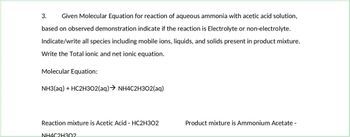
Chemistry
10th Edition
ISBN: 9781305957404
Author: Steven S. Zumdahl, Susan A. Zumdahl, Donald J. DeCoste
Publisher: Cengage Learning
expand_more
expand_more
format_list_bulleted
Concept explainers
Question

Transcribed Image Text:3. Given Molecular Equation for reaction of aqueous ammonia with acetic acid solution,
based on observed demonstration indicate if the reaction is Electrolyte or non-electrolyte.
Indicate/write all species including mobile ions, liquids, and solids present in product mixture.
Write the Total ionic and net ionic equation.
Molecular Equation:
NH3(aq) + HC2H302(aq) → NH4C2H302(aq)
Reaction mixture is Acetic Acid - HC2H302
NH4C2H302
Product mixture is Ammonium Acetate -
Expert Solution
This question has been solved!
Explore an expertly crafted, step-by-step solution for a thorough understanding of key concepts.
This is a popular solution
Trending nowThis is a popular solution!
Step by stepSolved in 2 steps

Knowledge Booster
Learn more about
Need a deep-dive on the concept behind this application? Look no further. Learn more about this topic, chemistry and related others by exploring similar questions and additional content below.Similar questions
- Complete and balance the following molecular reaction. Write the ionic and net ionic reactions. ___ BaCl2 (aq) + ___ Na2SO4 (aq) =arrow_forwardWrite the net ionic equation for the following molecular equation. 3Ca(NO3)2(aq) + 2Na3PO4(aq) → Ca3(PO4)2 (s) + 6NaNO3(aq) (Use the lowest possible coefficients. Be sure to specify states such as (aq) or (s). If a box is not needed, leave it blank.) +arrow_forwardNa2CO3arrow_forward
- The dilution equation, rearranged to solve for ?1 is ?1=?2?2?1 where ?1 and ?1 are the initial concentration and volume, respectively, and ?2 and ?2 represent the final concentration and volume, respectively. A student needs to prepare 50.0 mL of 1.10 M aqueous H2O2 solution from 4.8 M H2O2 stock solution. Set up an equation to solve for the volume of stock solution needed by plugging the given values into the equation.arrow_forwardNa2SO4arrow_forwardF12 F11 ID: A Date: Class: ID: A 24. 6. The amount of calcium present in milk can be determined by adding oxalate to a sample and measuring the mass of calcium oxalate precipitated. What is the mass percent of calcium if 0.429 g of calcium oxalate forms in a 125-g sample of milk when excess aqueous sodium oxalate is added? Na,C2O4(aq) + Ca²*(aq) → CaC2O4(s) + 2Na*(aq) a. 0.107% b. 0.202% с. 0.343% d. 1.10% е. 1.37% 25. Identify all the spectator ions in the following reaction. KSO4(aq) + 2MNSO4(aq) + 5FE2(SO4)3(aq)arrow_forward
- A reaction is carried out by mixing together a solution of HF and a solution of NaOH. HF (aq) + NaOн (аq) —> н,О (1) Assume the purple particles below each represent 1 mole of particles. Construct the balanced net ionic equation by dragging the purple components into the gray boxes. Drag each unreacted spectator ion along with its balancing coefficient into the blue box that represents the aqueous solution. Remember when you identify spectator ions to look carefully at what changes chemically! + NaF (aq)arrow_forwardThe reaction of hypothetical elements: A, B, C, D, and E, follows the molecular equation: AB2(aq) + CDE(aq) -> AE(s) + CB(aq) + DB(aq) Assuming that all aqueous compounds would fully dissociate, indicate the element/s that would form spectator ions in the subsequent total ionic equation.arrow_forwardThis question has multiple parts. Work all the parts to get the most points. Complete and balance the equation for the following acid-base reaction. Name the reactants. Assume complete neutralization. (Use the lowest possible coefficients. Use the pull-down boxes to specify states such as (ag) or (s). If a box is not needed, leave it blanl H3 AsO4 (aq) + NaOH(aq) → |H3 AsO4 (aq) + NaOH(aq)arrow_forward
arrow_back_ios
arrow_forward_ios
Recommended textbooks for you
 ChemistryChemistryISBN:9781305957404Author:Steven S. Zumdahl, Susan A. Zumdahl, Donald J. DeCostePublisher:Cengage Learning
ChemistryChemistryISBN:9781305957404Author:Steven S. Zumdahl, Susan A. Zumdahl, Donald J. DeCostePublisher:Cengage Learning ChemistryChemistryISBN:9781259911156Author:Raymond Chang Dr., Jason Overby ProfessorPublisher:McGraw-Hill Education
ChemistryChemistryISBN:9781259911156Author:Raymond Chang Dr., Jason Overby ProfessorPublisher:McGraw-Hill Education Principles of Instrumental AnalysisChemistryISBN:9781305577213Author:Douglas A. Skoog, F. James Holler, Stanley R. CrouchPublisher:Cengage Learning
Principles of Instrumental AnalysisChemistryISBN:9781305577213Author:Douglas A. Skoog, F. James Holler, Stanley R. CrouchPublisher:Cengage Learning Organic ChemistryChemistryISBN:9780078021558Author:Janice Gorzynski Smith Dr.Publisher:McGraw-Hill Education
Organic ChemistryChemistryISBN:9780078021558Author:Janice Gorzynski Smith Dr.Publisher:McGraw-Hill Education Chemistry: Principles and ReactionsChemistryISBN:9781305079373Author:William L. Masterton, Cecile N. HurleyPublisher:Cengage Learning
Chemistry: Principles and ReactionsChemistryISBN:9781305079373Author:William L. Masterton, Cecile N. HurleyPublisher:Cengage Learning Elementary Principles of Chemical Processes, Bind...ChemistryISBN:9781118431221Author:Richard M. Felder, Ronald W. Rousseau, Lisa G. BullardPublisher:WILEY
Elementary Principles of Chemical Processes, Bind...ChemistryISBN:9781118431221Author:Richard M. Felder, Ronald W. Rousseau, Lisa G. BullardPublisher:WILEY

Chemistry
Chemistry
ISBN:9781305957404
Author:Steven S. Zumdahl, Susan A. Zumdahl, Donald J. DeCoste
Publisher:Cengage Learning

Chemistry
Chemistry
ISBN:9781259911156
Author:Raymond Chang Dr., Jason Overby Professor
Publisher:McGraw-Hill Education

Principles of Instrumental Analysis
Chemistry
ISBN:9781305577213
Author:Douglas A. Skoog, F. James Holler, Stanley R. Crouch
Publisher:Cengage Learning

Organic Chemistry
Chemistry
ISBN:9780078021558
Author:Janice Gorzynski Smith Dr.
Publisher:McGraw-Hill Education

Chemistry: Principles and Reactions
Chemistry
ISBN:9781305079373
Author:William L. Masterton, Cecile N. Hurley
Publisher:Cengage Learning

Elementary Principles of Chemical Processes, Bind...
Chemistry
ISBN:9781118431221
Author:Richard M. Felder, Ronald W. Rousseau, Lisa G. Bullard
Publisher:WILEY